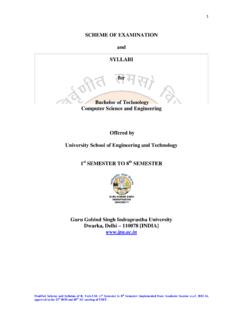Transcription of Performance of Bachelor of Science in Information ...
1 Performance of Bachelor of Science in Information Technology (BSIT). Students in their On-the-Job Training (OJT) for the Academic Year 2016-2017. JEFFERSON L. LERIOS and SHERWIN B. SAPIN. Assistant Professors, College of Computer Studies Laguna State Polytechnic University-Los Ba os Campus Abstract Students' Performance in their respective On-the-Job Training (OJT) is one of the success stories that may provide significant contribution to the total effectiveness of the curriculum designed and participated by stakeholders from various industry representation. Students were deployed in different companies to gain knowledge, skills, attitudes, and actual working experience for them to become more competitive upon completion of training and serve as input for their future career in his/her chosen field. This study aimed to assess and evaluate the OJT Performance of BSIT students in their respective companies for Academic Year 2016-2017.
2 Descriptive-survey research was employed in this study. A total of 58 students were selected to represent as the main respondents of the study. Findings revealed that their OJT Performance was at Very Satisfactory level. The study recommended that the College of Computer Studies may establish a strong partnership and linkages with various companies, especially those with IT departments which accept student-trainees. April 2017. Introduction On-the-job training, also known as OJT, is teaching the skills, knowledge, and competencies that are needed for employees to perform a specific job within the workplace and work environment. Employees learn in an environment in which they will need to practice the knowledge and skills taught in the on-the-job training (Heathfield, 2016). Exposure to actual working environment plays an important role in the development of future professionals in various fields of specialization.
3 Thru this, numbered higher education institutions (HEIs) is establishing their best to provide an effective OJT program integrated and implemented in some of their curricular offerings. Any organization that wants to succeed, and to continue to succeed, has to maintain workforce consisting of people who are willing to learn and develop continuously. Training and developing human capital is tremendously important in the effective management and maintenance of a skilled workforce. Training is one of the ways of improving organization's effectiveness. In order to implement right training methods, organization should be aware of the training methods and their effectiveness (Alipour, 2009). The College of Computer Studies (CCS) of Laguna State Polytechnic University- Los Ba os Campus (LSPU-LBC) offers Bachelor of Science in Information Technology (BSIT) degree program that incorporates OJT in the curriculum.
4 Students were deployed in different companies to render their Practicum or OJT which lasted for four hundred ninety (490) hours. This study was conceptualized to assess and evaluate the Performance of BSIT. students that had undergone OJT in their respective companies. Furthermore, the study will provide significant Information that may serve as good input to the continuous improvement and effective delivery of the CCS' OJT Program and to other curricular programs of the University-Campus as well. Research Objectives, Questions and Hypotheses The main objective of this study is to assess and evaluate the Performance of BSIT students in their OJT for the Academic Year 2016-2017 and the following questions were answered: 1. What is the respondent's socio-demographic profile in terms of Age, Gender, Company Name, and Department? 2. What is the respondent's mean assessment on the OJT Program of CCS in terms of College, Company, Personal and Over-all?
5 3. What is the respondent's Performance evaluation score in terms of Job Knowledge, Dependability, Communication Skills, Conduct, Initiative and Creativity, Cooperatives and Relationship and Attendance and Punctuality? 4. What is the respondent's level of Performance in OJT? 5. What is the respondent's over-all perception on the level of effectiveness of OJT Program of CCS? 6. Is there any significant relationship between the respondent's socio- demographic profile and mean assessment of the OJT Program of CCS in terms of College, Company, Personal, and Over-all? 7. Is there any significant relationship between the respondent's socio- demographic profile and Performance evaluation score in terms of Job Knowledge, Dependability, Communication Skills, Conduct, Initiative and Creativity, Cooperatives and Relationship and Attendance and Punctuality?
6 8. Is there any significant relationship between the respondent's socio- demographic profile and level of Performance in OJT? 9. Is there any significant relationship between the respondent's mean assessment of the OJT Program of CCS and Performance evaluation score in terms of Job Knowledge, Dependability, Communication Skills, Conduct, Initiative and Creativity, Cooperatives and Relationship and Attendance and Punctuality? 10. Do the following singly or in combination predict the respondent's over-all perception on the level of effectiveness of OJT Program of CCS: a. Socio-demographic Profile, b. Program Assessment, c. Performance Evaluation? Based on the above questions, the following hypotheses were derived and tested at 5% level of significance: 1. There is no significant relationship between the respondent's socio- demographic profile and mean assessment of the OJT Program of CCS in terms of College, Company, Personal, and Over-all.
7 2. There is no significant relationship between the respondent's socio- demographic profile and Performance evaluation score in terms of Job Knowledge, Dependability, Communication Skills, Conduct, Initiative and Creativity, Cooperatives and Relationship and Attendance and Punctuality. 3. There is no significant relationship between the respondent's socio- demographic profile and level of Performance in OJT. 4. There is no significant relationship between the respondent's mean assessment of the OJT Program of CCS and Performance evaluation score in terms of Job Knowledge, Dependability, Communication Skills, Conduct, Initiative and Creativity, Cooperatives and Relationship and Attendance and Punctuality? 5. None among the following singly or in combination predict the respondent's over-all perception on the level of effectiveness of OJT Program of CCS: a.
8 Socio-demographic Profile, b. Program Assessment, c. Performance Evaluation. Research Methodology The research design implemented in this study is the Descriptive-Survey. This design was adopted by the researchers for they strongly believed that this was the most suited and appropriate in analyzing and interpreting the data collected and to eventually come up with better findings, conclusions, and recommendations. The respondents of this study are the conveniently selected fourth year BSIT. students that had successfully completed their OJT and attended the College' General Assembly Meeting. Moreover, this utilized the Performance Evaluation Sheet and Program Assessment Questionnaire as its main instruments to solicit the data needed for analysis and interpretations. Furthermore, the researchers had used various statistical tests of the measurement and validation of the research questions and hypotheses.
9 Results and Discussion Table 1. Age Distribution of the Respondents Age Male Female Total Percent 19 2 4 6 20 12 11 23 21 10 7 17 22 2 2 4 23 1 1 2 25 1 0 1 26 3 1 4 28 1 0 1 Total 32 26 58 100. From the total population of 119 officially enrolled students in OJT for Academic Year 2016-2017 fifty-eight (58) was conveniently selected as target respondents. The socio-demographic profile of the respondents, Table 1 showed that the highest frequency in terms of Age was 20 years old and that represents twenty-three (23/58 or ) of the total respondents which comprises of twelve (12) males and eleven (11). females. Table 2. List of Identified Companies Company Male Female Total Percent Bureau of Plant Industry 0 2 2 CPIP-Batino BC Rizal Commercial Banking Corp. 1 1 2 DENR-CALABARZON 2 0 2 DENR-ERDB 5 4 9 DENR-PENRO 3 1 4 DOST-FPRDI 4 0 4 DOST-PCAARRD 2 3 5 HealthServ Los Ba os Medical Center 0 2 2 IRRI 1 2 3 LandBank-UPLB 1 0 1 Municipality of Los Ba os 2 0 2 PAGIBIG Fund - Calamba City 2 3 5 PLDT-Calamba City 1 0 1 PLDT-Los Ba os 1 3 4 Rural Bank of Mabitac - Los Ba os Branch 1 1 2 SSS-Calamba City 3 0 3 UPLB 2 3 5 UPLB Foundation, Incorporated 1 0 1 UPOU 0 1 1 Total 32 26 58 100.
10 Among the 19 companies identified shown in Table 2, nine (9/58 or ). completed their OJT in the Ecosystems Research Development Bureau (ERDB) of the Department of Environment and Natural Resources (DENR) located in Los Ba os, Laguna, Philippines. Table 3. Department Distribution Department/Section/Unit Male Female Total Percent IT-Related 12 7 19 Non-IT 20 19 39 Total 32 26 58 100. Based from the Department/Section/Unit of assignments reflected in Table 3, majority or thirty-nine (39/58 or ) of the respondents completed their OJT in a Non-IT workplace (or department) and the remaining nineteen (19 or ) were assigned in the IT-related workplace. Table 4. Performance Mean Score Terms Mean Score Job Knowledge Dependability Communication Skills Conduct Initiative and Creativity Cooperatives and Relationship Attendance and Punctuality Depicted in Table 4 are the Performance mean scores of the respondents based on the evaluation done by their respective immediate supervisors.














